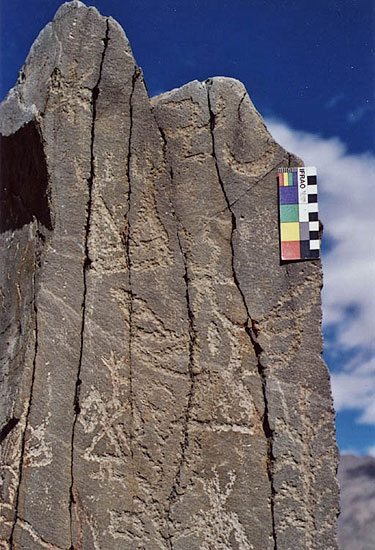previous image || Metal and Stone Vestiges main article || next image
Metal
and Stone Vestiges
Religion, Magic and Protection in the Art of Ancient Tibet
Image 15a
This extremely consequential petroglyphic panel exhibits an integrated array of Bon symbols (for a more comprehensive view of this panel see Images of Lost Civilization at asianart.com). From top to bottom, the elements of the panel include: sun, counterclockwise swastika, crescent moon, a pair of Bon shrines, khyung, figure with ornithic traits, tree or plant (right edge), tree or standard (center left), and anthropomorph with a three-pronged crown or feathers. These carvings were either made in the pre-Buddhist or early Buddhist period. These indigenous religious symbols are ordered in a vertical hierarchy, reflecting the orientation of the Bon cosmos into three layers (sipa sum). At the top of the rock slab the sun and moon, two main components of the Bon cosmos, flank the cosmogonic swastika (see Image set 18). In Tibetan culture, the sun and moon often symbolize the female and male elements respectively. Below these is a pair of objects that has the appearance of Bon shrines. They comprise slender pyramidal forms that rest on small square bases. The structures are crowned by prominent trident-like finials. They appear to be an early form of a Bon tabernacle or deity support receptacle of the lhatsug, tenkhar or sekhar class. Their placement near the top of the narrative scene suggests that they are cosmological vessels or models as well. In Tibetan religion, living beings and the universe are described by the metaphor, ‘the contents (cud) and vessel (nöd)’. The large khyung in the center of the image is depicted
in typical fashion with horns and fully spread wings. To its right is
a figure with a three-pronged crown (perhaps feathers or crown), a pointed
beak and bird-like arms. Such a figure could be a deity or human adept;
both are known to assume avian forms in the Bon tradition. Flanking
the lower part of the khyung is a tree or plant symbol (left)
and what could either be a tree or object of some type (such as a standard
or other ritual implement). At the bottom of the image is an anthropomorph
with a distinctive headdress of three points. This of course is reminiscent
of the Bon crown known as the ‘horns of the bird’ (charu).
It may be that the khyung, ornithic figure and anthropomorph
form three stages in a genealogical origination myth. The khyung
is the clan symbol of the Se-khyung clan, which hailed from the ancient
kingdom of Zhang Zhung (this rock art is found in what was a Zhang Zhung
region). The transition from fully avian to human in the three figures
may register the theogony of the Se-khyung clan and its descent
from the celestial realm (lha yul) to the earth (mi yul).
|
all text & images © John Vincent Bellezza
previous image || Metal and Stone Vestiges main article || next image
